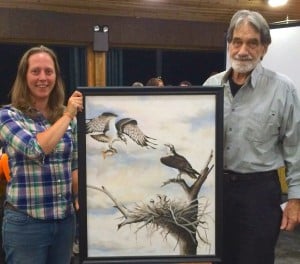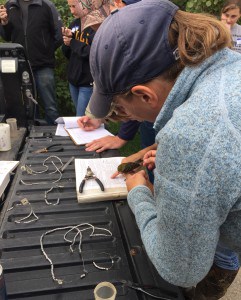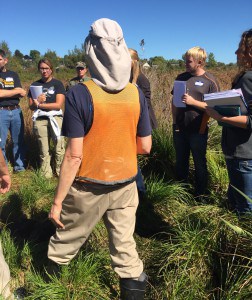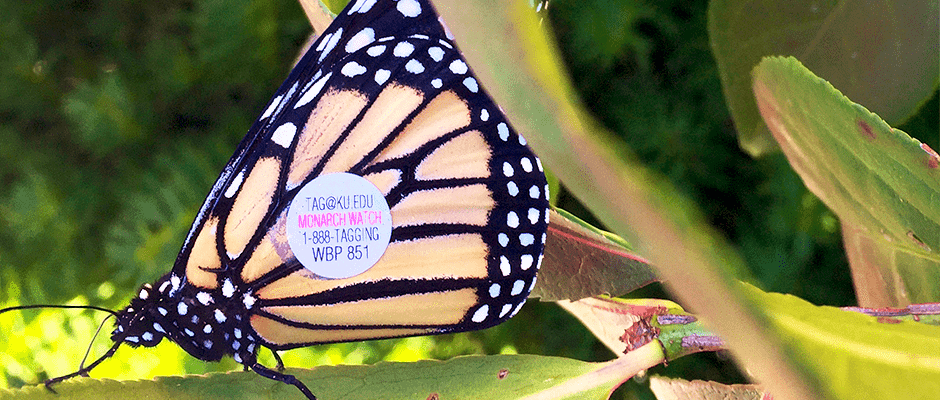Share this article
PATWS hosts multiple workshops during fall field day
The Pennsylvania Chapter of The Wildlife Society (PATWS) held its inaugural Fall Field Day over the weekend of September 23-24, 2016.

Emily Thomas (PATWS Past President) presented Dr. Charles P. “Hoagy” Schaadt with an osprey painting by wildlife artist Dave Hughes as part of the Gordon Kirkland Award for Lifetime Professional Achievement in Conservation, which Hoagy.
The event started on Friday night at the Elk Country Visitor Center in Benezette, PA. Students and wildlife professionals alike met at the Visitor Center annex building to view elk, eat excellent hors d’oeuvres, sip a glass of local wine and socialize. The evening was highlighted by the presentation, by Past President Emily Hope Thomas, of a beautiful, original painting of an osprey with nest and young to our Gordon Kirkland Award winner, Dr. Hoagy Schaadt. The painting was a framed multi-media creation by wildlife artist David Hughes of Hawk Mountain, PA.
After the presentation, a demonstration of bat mist-netting and acoustic detection techniques were presented by Normandeau Associates, Inc. USFWS Qualified Bat Surveyor Jason Collins. Echo location (acoustic) signals were detected using Normandeau’s proprietary acoustic equipment, and during two classroom workshops on Saturday included a review and speciation of the signatures collected on Friday night.
Elk were both heard and seen well into the evening after which participants drove to Dubois to spend the night.
More than 90 attendees and presenters were up bright and early to prepare for or attend the nine workshops offered in four sessions on the campus of Penn State Dubois.
Workshops presented were:
- Pennsylvania Elk: Status and Management – Jeremy Banfield
- Mist Netting and Bird Banding: Handling Nets and Birds – Emily Thomas
- Speed Training in Wetlands Delineation – Keith Maurice, Jane Rowan, Rob Blye
- Plant Identification for Wildlife Biologists – Rob Blye, Keith Maurice
- Non-lethal Wildlife Damage Management Methods – Tony Roland
- New Geospatial and Sensor Technologies for Quantifying Animal Behavior – Andrew McGann
- Raising and Tagging Monarch Butterflies: Educational Opportunities and Disease Challenges – Keely Roen
- The Secret Behind the Rattle: Timber Rattlesnakes – Stacy Foster
- An Introduction to Bat Sampling Technology – Jason Collins
The workshops were presented by professional wildlife biologists from federal and state agencies, academic institutions and the private consultants. Attendees included members of TWS Student Chapters from California University of Pennsylvania, Penn State University Dubois, Juniata College, and Delaware Valley University, students from Keystone College and Millersville University, advisors and professors from these schools, and professionals from state and federal agencies and consultants. In attendance was Penn State’s Dr. Margaret Brittingham, this year’s PATWS President.

Bird banding. ©Jane Rowan, PATWS Vice President
Rob Blye, assisted by Normandeau’s botanist Keith Maurice, presented two woody plant identification workshops with an emphasis on plants important to wildlife. Keith, with assistance from VP Jane Rowan and Rob Blye, also conducted a wetland delineation workshop, including field and classroom components. The wetland training captured 30 years of regulatory history and a complicated, three step process succinctly but in fully sufficient detail, with graphical illustrations in the classroom and hands-on observation in the field.
The highlights of the day were the gray-cheeked thrush, northern waterthrush, Lincoln’s sparrow and blackpoll warblers captured and banded in Emily Hope Thomas’ workshops. Also a plethora of American goldfinches, song sparrows, northern cardinals and gray catbirds were banded and released. Each attendee got to both help erect a mist net and handle birds as they were banded.
Early morning bird banders and early afternoon wetland delineators could see and hear the adjacent wildlife damage workshop conducted by Tony Roland as decoys were evident and gas cannons were exploding regularly. The afternoon bird banders got to hear the piercing hiss of timber rattlesnakes as workshop attendees learned about the life history, anatomy and biology of these fascinating snakes with real life examples presented by Stacy Foster.
The afternoon monarch banding project workshop conducted by Penn State Dubois Instructor Keely Roen is part of the Monarch Watch network. Workshop participants were given hands on opportunities to capture and tag monarch butterflies that would soon migrate south to Central America to begin their complex and generational life history cycle.

Wetland delineation workshop. ©Jane Rowan, PATWS Vice President
Andrew McGann’s workshop covered new GPS+Accelerometer tracking technologies available for wildlife telemetry projects. New technologies from the realms of smartphones, wearable fitness trackers, and quadcopter “drones” are now being incorporated into wildlife tracking devices, allowing researchers to address new and longstanding questions about animal movement and behavior. The wildlife telemetry devices from Cellular Tracking Technologies (CTT) employ cellular modems to connect the tracking devices directly to the Internet, allowing for the relatively inexpensive automated transfers of large amounts of telemetry data and options for remote reprogramming. The workshop also discussed the critical intersection of technology and ecology, in order to program and optimize sustainable data collection and transmission duty cycles to meet each project’s specific goals.
Lunch provided a great opportunity to meet new people, learn what they did and where, and exchange ideas on the newest techniques in wildlife research and management.
The article originally appeared in the PATWS Fall 2016 newsletter, available here. For more information on the Pennsylvania Chapter of TWS visit https://wildlife.org/pennsylvania-chapter/.
Header Image: Tagging Monarch butterflies workshop. ©Jane Rowan, PATWS Vice President








